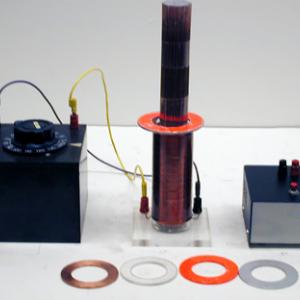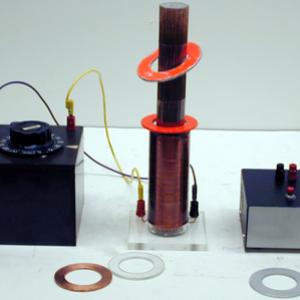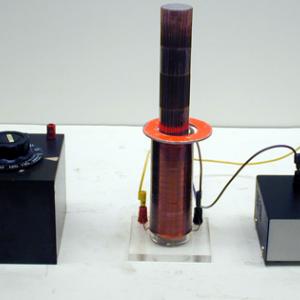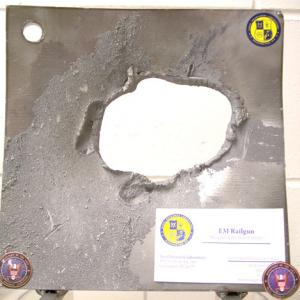College of Liberal Arts & Sciences
5K20.30 - Lenz's Law - Jumping Rings
Video Credit: Jonathan M. Sullivan-Wood.
Connect the electromagnet coil to a Variac. Insert the iron core and place a ring over the core. As you turn up the Variac the ring will appear to float. Use a split ring or non-ferromagnetic ring and observe no effect. Unplug the coil from the Variac and plug it into the pulse switch. This allows you to input 110 volts AC instantaneously. Place a ring over the core and hit the switch and the ring will jump about 20 feet into the air.
- Chiu-king Ng, "The Thomson Jumping Ring Experiment and Ideal Transformer", TPT, Vol. 60, #5, May 2022, p. 376.
- Patrick McCaughin, Lyle Ford, "Using the Thomson Jumping Ring to Study the Effect of Eddy Currents and Skin Depth on Ring Jump Height", TPT, Vol. 59, #6, Sept. 2021, p. 459.
- Andrew Duffy, "A Pictrorial Approach to Lenz's Law", TPT, Vol. 56, #4, Apr. 2018, p. 224.
- Rondo N. Jeffery and Farhang Amiri, "Thomson’s Jumping Ring Over a Long Coil", TPT, Vol. 56, #3, Mar. 2018, p. 176.
- Theodore Foster, Arthur Cary, John Mottmann, and Willem van Wyngaarden, "A New Version of an Old Demonstration Experiment Using the Elihu Thomson Jumping Ring Apparatus", TPT, Vol. 54, #8, Nov. 2016, p. 488.
- Rondo N. Jeffery and Farhang Amiri, "DC-Powered Jumping Ring", TPT, Vol. 54, #2, Feb. 2016, p. 112.
- Travis Z. Fullem and Michael S. Benedict, "A Simple Implementation of an Electromagnetic Coilgun Using a Camera Flash Circuit", TPT, Vol. 47, #3, Mar. 2009, p. 181.
- Rondo N. Jeffrey and Farhand Amiri, "The Phase Shift in the Jumping Ring", TPT, Vol. 46, #6, Sept. 2008, p. 350.
- Lester Evans, "Turbo Ring Flinger", TPT, Vol. 44, #4, Apr. 2006, p. 198.
- Aaron McAlexander, "PSSC Turbo Ring Flinger", TPT, Vol. 43, #9, Dec. 2005, p. 613.
- Kenneth E. Jesse, "Measuring Current in a Jumping Ring", TPT, Vol. 35, #4, Apr. 1997, p. 198.
- Jonathan Hall, "Forces on the Jumping Ring", TPT, Vol. 35, #2, Feb. 1997, p. 80.
- Dennis C. Henry and Sarah A. Danielson, "Experiments and Demonstrations with Soldering Guns", TPT, Vol. 31, #1, Jan. 1993, p. 42.
- Richard V. Mancuso, "Jumping Ring Referenced", TPT, Vol. 30, #4, Apr. 1992, p. 196.
- Thomas D. Rossing and John R. Hull, "Magnetic Levitation", TPT, Vol. 29, #9, Dec 1991, p. 552.
- R. S. Cheng and J. S. Trefil, "Moving Material into Space Without Rockets", TPT, Vol. 23, #3, Mar. 1985, p. 145.
- Arthur R. Quinton, "The Variation of Resistance with Temperature", TPT, Vol. 18, #3, Mar. 1980, p. 213.
- Arthur R. Quinton, "The AC Repulsion Demonstration of Elihu Thomson", TPT, Vol. 17, #1, Jan. 1979, p. 40.
- Thomas B. Greenslade, Jr., "Elihu Thomson Apparatus", AJP, Vol. 92, #10, Oct. 2024, p. 818.
- Paul J. H. Tjossem and Elizabeth C. Brost, "Optimizing Thomson's Jumping Ring", AJP, Vol. 79, #4, Apr. 2011, p. 353.
- Paul Tanner, Jeff Loebach, James Cook, and H. D. Hallen, "A Pulsed Jumping Ring Apparatus for Demonstration of Lenz's Law", AJP, Vol. 69, #8, Aug. 2001, p. 911.
- Paul J. H. Tjossem and Victor Cornejo, "Measurements and Mechanisms of Thomson's Jumping Ring", AJP, Vol. 68, #3, Mar. 2000, p. 238.
- Carl S. Schneider and John P. Ertel, "A Classroom Jumping Ring", AJP, Vol. 66, #8, Aug. 1998, p. 686.
- Benjamins S. Perkalskis and J. Reuben Freeman, "Extending Elihu Thomson's Demonstration and Lenz's Law", AJP, 65, #10, Oct. 1997, p. 1022.
- W. M. Saslow, "Electromechanical Implication of Faraday's Law: A Problem Collection", AJP, Vol. 55, #11, Nov. 1987, p. 986.
- S. Y. Mak and K. Young, "Floating Metal Ring in an Alternating Magnetic Field", AJP, Vol. 54, #9, Sept. 1986, p. 808.
- G. Wouch and A. E. Lord, Jr., "Eddy Currents: Levitation, Metal Detectors, and Induction Heating", AJP, Vol. 46, #5, May 1978, p. 464.
- E. J. Churchill, J. D. Noble, "A Demonstration of Lenz's Law?", AJP, Vol. 39, #3, March 1971, p. 285.
- Freier and Anderson, "Em-12", A Demonstration Handbook for Physics.
- B-260: Ring - Jumping and Heating", DICK and RAE Physics Demo Notebook.
- "B-270: Attraction of Levitating Rings", DICK and RAE Physics Demo Notebook.
- "B-265: Variable Levitation of Rings", DICK and RAE Physics Demo Notebook.
- "5,000-MPH Bullets That Don't Need Gunpowder", Popular Mechanics, Feb. 2016, p. 66.
- "Electro-Magnetic Railgun", Popular Science, June 2004, p. 65.
- David Kutliroff, "95, Lenz's Law and the Repulsion Coil", 101 Classroom Demonstrations and Experiment For Teaching Physics, p. 209.
- Julien Clinton Sprott, "5.3, Jumping Ring", Physics Demonstrations, ISBN 0-299-21580-6, p. 216.
- Yaakov Kraftmakher, "3.4, Eddy Currents", Experiments and Demonstrations in Physics, ISBN 981-256-602-3, p. 167.
- "Eddy Currents", Science Snackbook, p. 45.1 - 45.2.
- Jearl Walker, "6.22: Turning in the Shade of a Magnetic Field", The Flying Circus of Physics with Answers.
- Jearl Walker, "6.21: Electromagnetic Levitation", The Flying Circus of Physics with Answers.
- Christopher P. Jargodzki and Franklin Potter, "198, Repulsion Coil II", Mad About Physics, p. 75, 215.
- Christopher P. Jargodzki and Franklin Potter, "197, Repulsion Coil I", Mad About Physics, p. 74, 215.
- Brian Jones and Matt Fackelman, "Ring Shooter", Don't Forget the Duct Tape, p. 125 - 128.
Disclaimer: These demonstrations are provided only for illustrative use by persons affiliated with The University of Iowa and only under the direction of a trained instructor or physicist. The University of Iowa is not responsible for demonstrations performed by those using their own equipment or who choose to use this reference material for their own purpose. The demonstrations included here are within the public domain and can be found in materials contained in libraries, bookstores, and through electronic sources. Performing all or any portion of any of these demonstrations, with or without revisions not depicted here entails inherent risks. These risks include, without limitation, bodily injury (and possibly death), including risks to health that may be temporary or permanent and that may exacerbate a pre-existing medical condition; and property loss or damage. Anyone performing any part of these demonstrations, even with revisions, knowingly and voluntarily assumes all risks associated with them.



